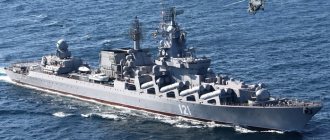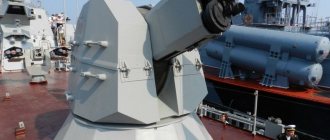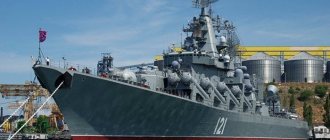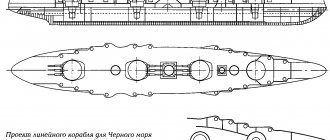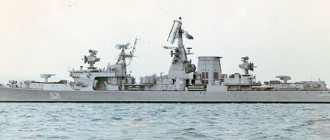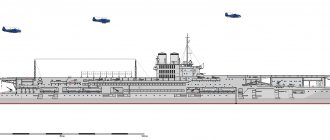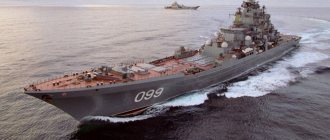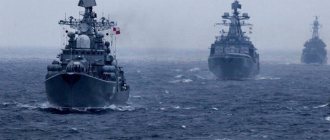May 13 is the Day of the Black Sea Fleet of the Russian Navy - an annual holiday celebrated in honor of the creation of the Black Sea Fleet.
The formation of the Black Sea Fleet began after the annexation of Crimea to the Russian Empire in 1783. The first basing point of the Black Sea Fleet was Akhtiarskaya (Sevastopol) Bay southwest of the Crimean Peninsula. It was here that the city of Sevastopol was founded. Now the Black Sea Flotilla is based at the Sevastopol and Novorossiysk naval bases.
What is the Russian Black Sea Fleet?
The Russian Black Sea Fleet performs the important task of protecting the territory of its country from attack by enemy forces.
The Black Sea Fleet is responsible for the security of Russia in the south.
The Black Sea Fleet includes ships of various types. Among them:
- Rocket.
- Linear.
- Sailing.
- Sentinels.
- Airborne.
- Sailing.
- Hydrographic.
- Rescue.
- Armadillos.
This is only a small part of the vessels that belong to the Black Sea Fleet. According to statistics, it also has submarines and surface ships that are designed to perform tasks in the ocean zone.
Since 2014, the Black Sea Fleet has been actively replenished with submarines that belong to the new generation of submarines. The state has allocated a huge amount of money from the budget for the development of the Black Sea Fleet.
History of the Russian Black Sea Fleet
Russia annually spends enormous resources on modernization and construction of modern ships.
The Black Sea Fleet, which belongs to the Russian Navy, has a rich history. It includes a number of fateful events that had a direct impact on the development of the military power of a given state.
In 1992, after the collapse of the Soviet Union, the navies of Ukraine and the Russian Federation were separated.
During 1995-1997, the Ukrainian naval forces and the Russian fleet were created. Each of them received its own territory for permanent base. In the same year, a lease agreement was signed. According to it, until May 28, 2022, the territory is transferred for temporary use for $98 million.
An important meeting between Dmitry Medvedev and Viktor Yanukovych, who were at that time the presidents of Russia and Ukraine, respectively, took place on April 21, 2010. Its goal was to sign an Agreement related to the presence of the Russian Federation fleet on the territory of Ukraine.
Denunciation of the Agreements
In March 2014, the main base of the Russian Black Sea Fleet in Sevastopol came under the jurisdiction of Russia. The Kharkov agreements, according to which the fleet was based in Crimea, were denounced by the Russian Federation due to the loss of the subject of the agreements. On March 18, 2014, an Agreement was signed between the Russian Federation and the Republic of Crimea on the formation of new entities within the Russian Federation.
Russian President Vladimir Putin instructed the government, together with the Ministry of Defense, to develop a program for the development of the Black Sea Fleet. The deadline for execution of the order is June 1, 2014. Those responsible for implementation are Russian Prime Minister Dmitry Medvedev and Defense Minister Sergei Shoigu .
Organization
The composition of the Russian Black Sea Fleet includes:
- Coastal troops.
- Submarine forces.
- Surface forces.
- Naval aviation.
The Black Sea Fleet also consists of ships and vessels. It includes the Hydrographic Service of the Navy and individual logistics units. Each composed of the Black Sea Military Fleet is responsible for a number of important tasks that must be carried out unquestioningly and in accordance with prescribed requirements and rules.
“Russia needs ocean-going ships - cruisers, frigates, aircraft carriers”
Which ships will join the Russian Navy in 2022
Russia needs a powerful, balanced navy, Russian President Vladimir Putin said at the Army 2021 forum. According to the head of state, by 2027 the share of modern ships should reach 70%. Gazeta.Ru looked into which ships are currently being built for the Navy and which will join its fleet in 2022.
By order of Putin, the construction of ships for the Russian Navy will begin at three shipyards. Two near-sea zone ships and four new submarines, including two nuclear-powered missile carriers, will be built at JSC Admiralty Shipyards in St. Petersburg, in Severodvinsk at JSC Sevmash and at PJSC Amur Shipyard in Komsomolsk-on-Amur .
Currently, the construction of Project 955A Borei-A ballistic missile submarines, Project 885M Yasen-M and Project 636.3 Varshavyanka multi-purpose submarines, and Project 20380 (20385) Steregushchiy-class multi-purpose corvettes continues.
“There are enough problems in the Navy. But the adopted development program is being implemented - both in terms of ship composition, and most importantly - in terms of the latest types of weapons. This is an unconditional positive. Today we have a fleet that is capable of ensuring security directly off the Russian coast - definitely. The Navy today responds to current threats. I would like the ships to be built faster and larger, but this is a question of the country’s economic capabilities,” Admiral Viktor Fedorov, commander of the Pacific Fleet in 2001-2007, told Gazeta.Ru.
Earlier it was reported that the shipyard was completing work on the transfer of two nuclear submarines to the Russian Navy - in 2022 it will be replenished by the strategic missile carrier Generalissimo Suvorov, the sixth ship of Project 955A Borei-A and the third, being built according to the modernized Project 955A (09552), and the nuclear attack submarine Krasnoyarsk, the fourth ship of Project 885M Yasen-M.
In August, Russian Defense Minister Sergei Shoigu said that by the end of the year the Northern Fleet would receive 238 units of new weapons. According to him, “new ships are being tested, including the nuclear submarines Prince Oleg, Novosibirsk and Belgorod, and a ship-based missile system with the Zircon hypersonic cruise missile, which will soon enter service with the Navy.”
In October, the Ministry of Defense announced the first two test launches of Zircon from the Project 885 Severodvinsk submarine - from surface and submerged positions. It was noted that
the submarine's missile control system and the missile itself operated as normal without any problems. According to the Ministry of Defense, the test goals were achieved - the underwater launch of the missile was worked out and confirmed.
According to the deputy director of the Institute of Political and Military Analysis, Alexander Khramchikhin, despite the development of the shipbuilding industry and the successful implementation of plans to modernize the Russian Navy, it remains “the most problematic area for objective reasons.”
“The fleet takes the longest to build and is the most expensive. In Russia, things are not very good with shipbuilding production capacities; it is in this area that we have lost a lot - large ship factories remained in Ukraine. More ships are now being retired than are being built, and this is difficult to compensate for. The situation in different fleets is different,” the expert said.
According to Khramchikhin, compared to other fleets, “the Pacific Fleet (PF) is in distress.”
“The Pacific Fleet is too large an operational zone, and the current composition of forces is not enough to provide a full solution to problems, primarily in the far ocean zone. But this is a matter of the near future, when new ships of the far sea zone will arrive at the Pacific Fleet, and submarine forces will also be built up. In the coastal zone, the Pacific Fleet solves its problems; it is capable of ensuring the economic activity of both the fishing industry and all Russian oil and gas enterprises in this economic zone,” Fedorov noted.
Earlier, the commander of the Pacific Fleet, Admiral Sergei Avakyants, said in an interview with the Krasnaya Zvezda newspaper that the corvettes “Perfect”, “Gromky” and “Hero of the Russian Federation Aldar Tsydenzhapov” showed success in missile firing with the Redut anti-aircraft missile system against Malachite target missiles. in the Sea of Japan. Also, the Pacific Fleet Marine Corps was one of the first in the Russian Navy to master the latest BMP-3 infantry fighting vehicles of the naval modification.
“The third Project 636.3 diesel submarine Magadan recently joined the Pacific Fleet. We are waiting for her at her home base in 2022, after completing the inter-fleet transition from the Baltic Fleet, where she is currently located. Also in 2022, the fourth submarine of this project, the Ufa, will join the fleet. Quite recently in Vladivostok, the fourth corvette of Project 20380 “Rezkiy”, built at the Amur Shipyard, was launched from a transport dock for the Pacific Fleet. At the same plant in August of this year, the keel of the Project 20380 Grozny corvettes and the Project 20385 Buiny corvette were laid down. In September, the sixth corvette of Project 20380 “Braviy” was laid down for the Pacific Fleet,” Avakyants said.
Currently, four small Project 22800 missile ships “Rzhev”, “Udomlya”, “Ussuriysk” and “Pavlovsk” are being built for the Pacific Fleet in Komsomolsk-on-Amur; it is planned to modernize the large anti-submarine ship “Admiral Vinogradov” of Project 1155.
Speaking about the Black Sea Fleet (BSF), military expert Viktor Litovkin noted the importance of its current strengthening against the background of the aggravated military-political situation in the region. This year, the United States and its NATO allies have increased their activity in the Black Sea.
According to Litovkin, the big disadvantage of the Navy is that “large shipyards are not being built or their construction is proceeding slowly.”
“Russia needs factories for large-capacity ships; it cannot only own a coastal fleet. She needs to create ocean ships - cruisers, frigates, and prepare the ground for the construction of aircraft carriers. Aircraft carriers are needed.
It’s time to decide which ones - with a nuclear power plant or a gas turbine, with a catapult or a springboard,” the expert said.
Litovkin emphasized that the Navy is not only ships. “This includes the coast, aviation, air defense and missile defense systems. The Navy also includes bases in various areas of the world's oceans. This is also a powerful rear capable of providing the fleet with everything it needs. When the Russian Navy develops as a complex, then it will be invincible,” Litovkin believes.
Irina Alshaeva
Base points
Since 2022, the military base has thirteen more new military vessels, many of which are equipped with the Kalibr missile system. The Black
Sea Fleet of the Russian Federation is located at the Sevastopol and Novorossiysk naval base.
Sevastopol is considered the main naval base of the Russian Black Sea Fleet.
The main base of the Black Sea Fleet is located simultaneously in three bays of Sevastopol. We are talking about Quarantine, Northern and Southern. This also includes a number of berths.
The Sevastopol Novorossiysk naval base complements it. This is a fairly young formation that has already managed to successfully consolidate its positions in the allotted territory. This object is located on the Caucasian coast, which belongs to the Black Sea.
These base points were chosen for a reason. These are the optimal locations for a fleet capable of defending the borders of its state, which are washed by the Black Sea. They are also suitable for ensuring successful sea transport if the need arises.
Equipment and weapons
The Black Sea Fleet owns a group of vessels that are used to carry out tasks assigned by senior management. These include:
- Missile cruiser "Moscow".
- Patrol ship "Sharp-witted".
- Patrol ship "Ladny".
- Frigate "Admiral Essen".
- Frigate "Admiral Grigorovich".
- Frigate "Admiral Makarov".
- Small high-speed missile ship "Bora".
- Small high-speed missile ship "Samum".
This list can be supplemented by small missile ships, missile boats and submarines.
The Black Sea Fleet's weapons include naval, universal and anti-aircraft guns, missile systems of various types, anchor mines, torpedo tubes, bomb launchers and depth charges.
Currently, vessels and ships that belong to the Navy of the Russian Federation do not have prefixes next to their names.
Russian Black Sea Fleet Part I
Russian Black Sea Fleet Part I
The Black Sea Fleet of the Russian Federation is the operational-strategic formation of the Russian Navy on the Black Sea, which is part of the Southern Military District of the Russian Armed Forces. Its main objectives are: protection of national interests; conducting combat operations in sea and ocean theaters; ensuring the safety of areas of production activity; ensuring navigation safety; ensuring the naval presence of the Russian Federation in the World Ocean (visits, business visits, joint exercises, actions as part of peacekeeping forces, etc.); participation in military, humanitarian and peacekeeping actions carried out by the world community that meet the interests of the Russian Federation. The fleet was founded in 1783 by decree of Empress Catherine II the Great .
The main bases of the Russian Black Sea Fleet are the ports of Sevastopol and Novorossiysk.
The main forces of the fleet are based in Sevastopol: the 30th division of surface ships, which includes the 11th brigade of anti-submarine ships and the 197th brigade of landing ships. They are the basis of the combat power of the Black Sea Fleet. The submarine forces are represented by the 247th separate submarine division. The ships and boats of the 41st brigade of missile boats, the 400th division of anti-submarine ships and mine countermeasures ships are based in Sevastopol.
418th minesweeper battalion. Sevastopol is also the base for ships and vessels of the 519th division of reconnaissance ships, the 37th brigade of rescue ships, the 422nd division of hydrographic vessels and the 9th brigade of maritime support vessels. The ships of the 184th brigade of water area protection ships are based in Novorossiysk, which includes the 181st division of small anti-submarine ships and the 170th division of minesweepers. There are small connections in Temryuk and Feodosia. The Black Sea Fleet (as of March 2014) includes: a missile cruiser, a large anti-submarine ship, three patrol ships, a non-nuclear submarine (-1-1 under repair), 2 missile ships, 2 small missile ships, 5 missile boats, 7 small anti-submarine ships, 12 mine-anti-sabotage ships, 7 large landing ships, 2 landing craft and 5 anti-sabotage boats. In addition to warships and boats, the Russian Black Sea Fleet includes: reconnaissance ships, special-purpose ships and vessels, rescue ships and boats (UPASR Navy), hydrographic ships and boats (GS Navy), ships, boats and watercraft of the auxiliary fleet. In addition, the Russian Black Sea Fleet includes: naval aviation, marine infantry, coastal troops and logistics service. The fleet headquarters is located in Sevastopol.
The commander of the Black Sea Fleet is Vice Admiral Alexander Viktorovich Vitko.
Alexander Viktorovich Vitko (born September 13, 1961, Vitebsk, BSSR, USSR) - Russian military leader, commander of the Black Sea Fleet of the Russian Navy since April 15, 2013, admiral (May 5, 2014), Candidate of Military Sciences
The Black Sea Fleet is the operational-strategic formation of the Russian Navy in the Black Sea. As of May 2016, the fleet includes 277 49 are warships ), personnel - at least 25 thousand military personnel.
| Rank 1 warships |
| Guards missile cruiser "Moskva" project 1164 |
The cruisers of this project are designed to strike large ships and strike groups of the enemy fleet, they ensure the combat stability of ship-based anti-submarine search and strike groups and large fleet formations, and solve the problems of collective air defense of fleet formations in the far sea and ocean zone. They received an all-mode gas turbine unit, modern strike and defensive weapons and electronic equipment as a power plant. Of all the warships of our fleet, in terms of their combat capabilities, the Project 1164 RKA is second only to the Project 1143.5 TAVKR and the Project 1144.2 TARKR. NATO calls them “aircraft carrier killers.”
In the fleet since 1983
| Tactical and technical characteristics of the missile cruiser "Moskva" project 1164 |
| Displacement (standard/full): 9800/11300 t; Dimensions: 186x20.8x8.4 m; Power plant: 5 turbines = 108,000 hp; Speed: 32 knots; Cruising range: 2500 miles (30 knots), 6800 miles (18 knots); Crew: 476 people (including 66 officers); Armament: 16 launchers of anti-ship missiles of the "Basalt" complex, 8x8 vertical launchers of anti-aircraft missiles of the "Fort" complex, 2x2 launchers of anti-aircraft missiles of the "Osa-M" complex, 1x2-130-mm AK-130, 6x6-30 -mm AK-630, 2 RBU-6000, 2x5-533-mm TA, 1 KA-27 helicopter (in the hangar) |
| Large anti-submarine ship "Kerch" project 1134B |
The ships of this project are a further development of the 1134 and 1134A series. They received a gas turbine unit with reversible turbines as a power plant, anti-aircraft and air defense weapons were strengthened, and more advanced electronic equipment and sonar were installed. BODs are designed to search and destroy enemy submarine forces in the far sea and ocean zones, provide anti-aircraft defense and air defense to fleet formations and ensure the combat stability of ship-based anti-submarine search and strike groups. "Kerch" is the last operational ship of this project.
In the fleet since 1974
External view diagram of BOD pr. 1134B:
1 – runway for the Ka-25PL helicopter; 2 – starting command post; 3 – RBU-1000; 4 – launcher of the “Storm” air defense system; 5 – AP radar SU “Grom-M”; 6 – AP identification station “friend-foe”; 7 – AP SU ADMS “Osa-M”; 8 – AP stations “Gurzuf A” and “Gurzuf B”; 9 – AP radar “Volga”; 10 – AP radar “Voskhod”; 11 – AP of the radio direction finder ARP-50R; 12 – 76-mm AU AK-726; 13 – AP station “Zaliv”; 14 – AP radar “Angara-A”; 15 – optical periscopic sight of the GKP; 16 – stabilized post of the TV system for monitoring the near surface situation MT-45; 17 – optical periscopic sight of the wheelhouse; 18 – AP radar “Don-2”; 19 – wheelhouse; 20 – PU NURS SPPP PK-2; 21 – RBU-6000; 22 – radome of the Titan-2T GAS antenna; 23 – antenna fairing for GAS ZPS and identification of MG-26; 24 – PU PLRK “Metel”; 25 – AP radar SUAO “Turel”; 26 – AP of the electronic warfare system “Ring” (38*); 27 – Osa-M air defense missile launcher; 28 – 30 mm AU AK-630M; 29 – AP radar SUAO “Vympel-A”; 30 – command boat; 31 – 533-mm TA PTA-53-1134B; 32 – lapport of the GAS “Vega” antenna room; 33 – AP of the “Gateway” system.
| Tactical and technical characteristics of the anti-submarine ship "Kerch" of project 1134B |
| Displacement (standard/full): 6700/8565t; Dimensions: 173.4x18.5x5.7 m; Power plant: 8 turbines = 96,000 l. With.; Speed: 32 knots; 3000 miles (32 kts), 6500 miles (18 kts); Crew: 380 people (including 47 officers); Armament: 2x4 launchers of anti-submarine guided missile-torpedoes "Metel", 2x2 launchers of anti-aircraft missiles of the "Storm" complex, 2x2 launchers of anti-aircraft missiles of the "Osa" complex, 2X2-76-MM AK-726, 4x6-30- mm AK-630, 2 RBU-6000, 2 RBU-1000, 2x5-533-mm TA, 1 KA-25 helicopter (in the hangar) |
| Rank 2 warships | |
| Project 01090 patrol ship "Smetlivy" | |
| Project 01090 ships were created to provide anti-aircraft defense and air defense to fleet formations in far and near sea zones, patrol in specified areas of the seas and oceans, support convoy and landing operations of fleet forces. Project 61 ships became a milestone for the Russian Navy due to the use of an all-mode gas turbine installation, guided missile weapons and the saturation of the ships with radio-electronic equipment. When modernization was carried out, their combat capabilities increased significantly and they became universal ships. For three decades they were the “face” of the ocean-going nuclear missile Navy of the USSR. Smetlivy is the last operational ship of this project in the Russian Navy. It is the oldest warship in the Russian Navy. In the fleet since 1969 Tactical and technical characteristics of the patrol ship "Smetlivy" of project 01090 |
| Displacement (standard/full): 3440/4290 t; Dimensions: 144x15.8x4.5 m; Power plant: 4 turbines = 72,000 hp; Speed: 34 knots; Cruising range: 2000 miles (30 knots), 3100 miles (24 knots), 3500 miles (18 knots); Crew: 266 people (including 22 officers); Armament: 2x4 anti-ship missile launchers of the Uran complex, 2 anti-aircraft missile launchers of the Volna-P complex, 1X2-76-MM AK-726, 2 RBU-6000, 1x5-533-mm TA, can take mines on board |
| Project 1135 patrol ship "Ladny" |
| Project 1135 ships are designed to search and destroy enemy submarine forces in far and near sea zones, provide anti-aircraft defense to fleet formations, cover convoy and landing operations of fleet forces, and patrol in specified areas of the seas and oceans. This project became the main type of patrol ship of the USSR Navy. The ships of the project are distinguished by excellent seaworthiness. "Ladny" is the last operational ship of this project. In the fleet since 1980 Tactical and technical characteristics of the Project 1135 patrol ship "Ladny" |
| Displacement (standard/full): 2810/3190 t; Dimensions: 123x14.2x7.2 m; Power plant: 4 turbines = 52000hp; Speed: 32 knots; Cruising range: 1240 miles (32 knots), 3515 miles (18 knots), 5000 miles (14 knots); Crew: 190 people (including 22 officers); Armament: 4 launchers of anti-submarine guided missile-torpedoes of the Metel complex, 2x2 launchers of anti-aircraft missiles of the Osa complex, 2x2-76-mm AK-726, 2 RBU-6000, 2x4-533-mm TA, can be carried on board mines |
| Project 1135M patrol ship "Pytlivy" |
Project 1135M ships are a further development of Project 1135. They received more powerful weapons and a new sonar. TFRs are designed to search and destroy enemy submarine forces in the far sea and ocean zones, provide anti-aircraft defense for fleet formations, cover convoy and landing operations of fleet forces, and patrol in specified areas of the seas and oceans. The ships of the project are distinguished by excellent seaworthiness. "Inquisitive" is the last operational ship of this project.
In the fleet since 1981
| Tactical and technical characteristics of the Project 1135M patrol ship "Pytlivy" |
| Displacement (standard/full): 2810/3250 t; Dimensions: 123 x 14.2 x 7.2 m; Power plant: 4 turbines = 52000 hp; Speed: 32 knots;, Cruising range: 1240 miles (32 knots), 3515 miles (18 knots), 5000 miles (14 knots); Crew: 190 people (including 22 officers); Armament: 4 launchers of anti-submarine guided torpedo missiles of the Metel complex, 2x2 launchers of anti-aircraft missiles of the Osa complex, 2x1-100 mm AK-100, 2 RBU-6000, 2x4-533 mm TA, can be carried on board mines |
| Project 877B submarine "Alrosa" |
| Project 877B submarines are designed to destroy enemy forces in far and near sea zones, operate on communications, and conduct mine laying. They are the most advanced non-nuclear submarines of the domestic fleet due to solving the issues of power supply, ensuring secrecy in all operating modes of the power plant, increasing the efficiency of weapons and electronic equipment. Instead of a propeller, ALROSA is equipped with a water-jet propulsion unit, which makes it the quietest among all submarines of the project. NATO calls them “black holes” because of the low noise and low level of the acoustic field of submarines. In the fleet since 1990 Tactical and technical characteristics of the Project 877B submarine "Alrosa" |
| Displacement (surface/underwater): 2300/3076 t; Dimensions: 72.6x9.9x6.2 m; Power plant: 2 diesel engines, 1 electric motor = 5,500 hp; Speed: 10/19 knots; Underwater range: 450 miles (3 knots), 6880 miles (7 knots); Autonomy: 45 days; Immersion depth: 350 m; Crew: 52 people (including 14 officers); Armament: 6-533-mm TA (ammunition 18 torpedoes or 24 mines), 8 launchers of the Igla-1 portable air defense system |
| Submarine "B-380" project 641B |
| Project 641B submarines are a further development of Project 641. They are distinguished by improved seaworthiness, more advanced batteries, and new electronic equipment. Project 641B submarines are designed to destroy enemy forces in far and near sea zones, operate on communications, conduct mine laying and patrol in specified areas. B-380 is the last operational submarine of this project. In the fleet since 1983. NB: Some sources indicate that the boat was named “Saint Prince George”. Since 2004, it has been under repair in Sevastopol, but currently all work on it has been suspended. Tactical and technical characteristics of the Project 641B submarine "B-380" |
| Displacement (surface/underwater): 2750/3546 t; Dimensions: 90.2x8.6x5.9 m; Power plant: 3 diesels, 3 electric motors = 5,400 hp; Speed: 13/16 knots; Autonomy: 80 days; Immersion depth: 300 m; Crew: 78 people (including 17 officers); Armament: 6-533 mm TA (ammunition 24 torpedoes or mines) |
| Project 1171 landing ships |
Landing ships of Project 1171 are designed to conduct landing operations on an unequipped coast, transporting troops with equipment, weapons and various cargoes. BDKs can load and unload equipment both from the shore and from the water. They are used as weapons transports in far and near sea zones.
As part of the Black Sea Fleet:
| "Nikolai Filchenkov" (1975, tail number 152), BDK-65 "Saratov" (1966, tail number 150), BDK-69 "Orsk" (1968, tail number 148). Tactical and technical characteristics of landing ships of Project 1171 |
| Displacement (standard/full): 3000/4650 t; Dimensions: 113.1x15.6x4.5 m; Power plant: 2 diesel engines = 9000 hp; Speed: 16.5 knots; Cruising range: 10,000 miles (15 kts); Crew: 69 people (including 5 officers); Armament: 1x2-57-mm ZIF-31B, 2x2-25-mm 2-M-ZM (only on Filchenkovo), 2x22 NURS Grad-M launchers (on Filchenkovo), 2x2 launchers portable air defense complex "Strela-3" Can take on board 313 people ("Filchenkov" - 400 people), 22 MBT and 25 armored personnel carriers, or 50 armored personnel carriers, or 52 trucks |
| Project 775-II landing ships |
Landing ships of Project 775-II are a further development of Project 775. The ships of this project are designed to conduct landing operations on an unequipped coast, transporting troops with equipment, weapons and various cargoes. BDKs can load and unload equipment both from the shore and from the water. Used as transport in far and near sea zones. Can be used to lay minefields.
As part of the Black Sea Fleet:
“Caesar Kunikov” (1986, tail number 158), “Novocherkassk” (1987, tail number 142), “Yamal” (1988, tail number 156).
| Tactical and technical characteristics of landing ships of Project 775-II |
| Displacement (standard/full): 2900/4400 t; Dimensions: 112.5x15x3.7 m; Power plant: 2 diesel engines = 19,200 hp; Speed: 17.5 knots; Cruising range: 3500 miles (16 knots), 6000 miles (12 knots); Crew: 87 people (including 17 officers); Armament: 2x2-57-mm AK-725, 2 NURS BM-22 Grad-M launchers, 2 Strela-3 portable air defense system launchers. Can carry 150 people, 13 MBTs, 13 armored personnel carriers or 20 trucks. Can carry mines |
| Landing ship "Azov" project 775-III |
| Landing ships of Project 775-III are a further development of Project 775. It received new weapons and electronic equipment. The ships of this project are designed to conduct landing operations on an unequipped coast, transporting troops with equipment, weapons and various cargoes. BDKs can load and unload equipment both from the shore and from the water. Used as transport in far and near sea zones. Can be used to lay minefields. In the fleet since 1990 Tactical and technical characteristics of the Azov landing ship of Project 775-III |
| Displacement (standard/full): 2900/4400 t; Dimensions: 112.5x15x3.7 m; Power plant: 2 diesel engines = 19,200 l. With.; Speed: 17.5 knots; Cruising range: 3500 miles (16 knots), 6000 miles (12 knots); Crew: 87 people (including 17 officers); Armament: 1-76 mm AK-176, 2x6-30 mm AK-630M, 2 launchers NURS BM-22 "Grad-M", 4 launchers of the portable air defense system "Strela-3". Can carry 150 people, 13 MBTs, 13 armored personnel carriers or 20 trucks. Can carry mines |
| Project 1239 missile ships |
Project 1239 rocket ships are unique in their design - they are catamarans made of aluminum-magnesium alloy with aerostatic air unloading (air cavity). As a power plant, they received a diesel-gas turbine unit in the form of two separate propulsion units with six propellers, which allows for a wide range of speeds and propulsion modes. Missile ships have powerful strike and defensive weapons and advanced electronic equipment. Their task is to destroy large surface ships and enemy fleet formations in the near sea zone. They have no analogues in any fleet in the world.
As part of the Black Sea Fleet:
“Bora” (1991, tail number 615), “Samum” (2000, tail number 616).
| Tactical and technical characteristics of Project 1239 missile ships |
| Displacement (standard/full): 850/1050 t; Dimensions: 63.9 x 17.2 x 1.7 m (with 3.3 m columns); Power plant: turbine 2×20000 hp, diesel 2×10000 hp. + 2×6600 hp; Speed: 50 knots (with lowering columns); Cruising range: 600 miles (50 knots), 2500 miles (12 knots); Crew: 68 people (including 9 officers); Armament: 2x4 launchers of anti-ship missiles of the Moskit complex, 1x2 launchers of anti-aircraft missiles of the Osa-M complex, 1-76-mm AU AK-176, 2x6-30-mm AU AK-630M |
| Rank 3 warships | |
| Small missile ships of project 1234.1 | |
Small missile ships of Project 1234.1 are a further development of Project 1234. They received powerful weapons and more advanced electronic equipment. RTOs are designed to destroy surface ships and enemy fleet formations in far and near sea zones, cover convoy and landing operations of fleet forces, and patrol in specified areas.
As part of the Black Sea Fleet:
“Mirage” (1986, tail number 617), “Calm” (1978, tail number 620).
| Tactical and technical characteristics of small missile ships of project 1234.1 |
| Displacement (standard/full): 610/700 t; Dimensions: 59.3x11.8x3 m; Power plant: diesel 3×10000 hp; Speed: 35 knots; Cruising range: 3500 miles (12 knots), 1600 miles (18 knots); Crew: 65 people (including 10 officers); Armament: 2x3 launchers of anti-ship missiles of the Malachite complex, 1 launcher of anti-aircraft missiles of the Osa-M complex, 1-76-mm AU AK-176, 1x6-30-mm AK-630M |
| Small anti-submarine ships of Project 1124M |
Small anti-submarine ships of Project 1124M are a further development of Project 1124. They received more powerful weapons, a new sonar and advanced electronic equipment. The ships of this project are designed to search and destroy enemy submarine forces in far and near sea zones, provide anti-aircraft defense and air defense to fleet formations, cover convoy and landing operations of fleet forces, and patrol in specified areas. They were built in several series, which differ slightly in performance characteristics. Project 1124M MPKs are the main escort ships of the Russian Navy.
As part of the Black Sea Fleet:
MPK-118 "Suzdalets" (1983, tail number 071), MPK-134 "Muromets" (1982, tail number 064), MPK-199 "Kasimov" (1986, tail number 055), MPK- 207 “Povorino” (1989, tail number 053), MPK-217 “Eysk” (1989, tail number 054).
| Tactical and technical characteristics of small anti-submarine ships of Project 1124M |
| Displacement (standard/full): 910/1055 t; Dimensions: 71.1x10.15x3.7 m; Power plant: 1 turbine, 2 diesel engines = 38,000 hp; Speed: 31.6 knots; Cruising range: 1750 miles (20 knots), 4000 miles (10 knots); Crew: 79 people (including 5 officers); Armament: 1-76-mm AU AK-176, 1x6-30-mm AK-630M, 1x2 launchers of anti-aircraft missiles of the Osa complex, 1 RBU-6000, 2x2-533-mm TA, 2 bomb releasers, can be taken on side of the mine |
| Small anti-submarine ship "Alexandrovets" project 1124 |
The small anti-submarine ship "Aleksandrovets" of Project 1124 is designed to search and destroy enemy submarine forces in far and near sea zones, provide anti-submarine warfare and air defense to fleet formations, cover convoy and landing operations of fleet forces, and patrol in specified areas. The ships of this project were the main escort ships of the USSR Navy. They were built in several series. The MPC received modern air defense and anti-aircraft weapons, two sonar systems, and new radio-electronic equipment.
| "Alexandrovets" is the last operational ship of the project. In the fleet since 1982 Tactical and technical characteristics of small anti-submarine ships of Project 1124 |
| Displacement (standard/full): 954/1070 t; Dimensions: 71.1x10.15x3.7 m; Power plant: 1 turbine, 2 diesel engines 38,000 hp; Speed: 31.6 knots; Cruising range: 4000 miles (10 kts); Crew: 79 people (including 5 officers); Armament: 1x2-57-mm AU AK-725, 1x2 launchers of anti-aircraft missiles of the Osa complex, 2 RBU-6000, 2x2-533-mm TA, 2 bomb releasers, can take mines on board |
| Small anti-submarine ship "Vladimirets" project 1145.1 |
The small anti-submarine ship "Vladimirets" of Project 1145.1 is a further development of Project 1141. It received new weapons, more advanced sonar and electronic equipment, and the design of the ship was improved. As a power plant, it received economical gas turbines, which allows it to provide a wide range of speeds and operating modes. Small anti-submarine ships are unique in their design - they are equipped with hydrofoils with automatically controlled flaps. Project 1145.1 MPKs are designed to search and destroy enemy submarine forces in far and near sea zones, provide anti-aircraft defense and air defense to fleet formations, cover convoy and landing operations of fleet forces, and patrol in specified areas. IPCs on PC have no analogues in any fleet in the world.
"Vladimirets" is the last operational ship of the series. In the fleet since 1991
| Tactical and technical characteristics of small anti-submarine ships of Project 1145.1 |
| Displacement (standard/full): 362/468.1 t; Dimensions: 50x9.9 (with wings 21.1)x2.2 (with wings 7.27 m); Power plant: 1 turbine, 2 diesel engines = 25,400 hp; Speed: 60.5 knots (on wings), 12.2 knots (on hull);, Cruising range: 1230 miles (10 knots); Crew: 39 people (including 5 officers); Armament: 1-76-mm AK-176 AU, 1x6-30-mm AK-630M AU, 2x4-224-mm TA, 1 launcher of the Strela-3 portable air defense system |
| Sea minesweeper "Zheleznyakov" project 12660 |
The sea minesweeper "Zheleznyakov" of Project 12660 is a new generation mine-resistant ship, which has received modern weapons, electronic equipment, and means of searching and destroying mines. For the first time in the Russian fleet, it can search for mines directly along the ship's path. MTSH is designed to search and destroy mines in far and near sea zones, cover convoy and landing operations of naval forces, and patrol in specified areas. MTSH Project 12660 are the most advanced mine-resistant ships of the Russian Navy.
In the fleet since 1988
| Tactical and technical characteristics of Project 12660 sea minesweepers |
| Displacement (standard/full): 1070/1228 t; Dimensions: 67.8x11x3.1 m; Power plant: 2 diesel engines = 5100 hp; Speed: 15.7 knots; Cruising range: 1500 miles (12 kts); Crew: 70 people (including 7 officers); Armament: 1x1-76 mm AK-176, 1x6-30 mm AK-630M, 4x4-406 mm TA, 1 launcher of the Igla portable air defense system, trawls and mine action systems |
| Sea minesweeper "Vice Admiral Zakharyin" project 02668 |
| The sea minesweeper "Vice Admiral Zakharyin" of project 02668 is a further development of project 266M. The ship received new weapons, mine-anti-mine systems (for example, GAS Livadia) and radio-electronic equipment. The minesweeper can search for mines directly along the ship's path. It is designed to search and destroy mines in far and near sea zones, cover convoy and landing operations of naval forces, and patrol in specified areas. In the fleet since 2009 Tactical and technical characteristics of sea minesweepers of project 02668 |
| Displacement (standard/full): 791/852 t; Dimensions: 61 x 10.2 x 2.9 m; Power plant: 2 diesel engines = 5000 hp; Speed: 17 knots; Cruising range: 3000 miles (12 kts); Crew: 68 people (including 6 officers); Armament: 1x6-30-mm AK-306, 2x1-14.5-mm, 1 launcher of the Igla-1 portable air defense system, trawls and anti-mine systems, can take mines on board |
| Sea minesweeper "Valentin Pikul" project 266ME |
| The sea minesweeper "Valentin Pikul" of Project 266ME is a further development of Project 266M. The ship received new weapons, mine protection systems and electronic equipment. The minesweeper is designed to search and destroy mines in far and near sea zones, cover convoy and landing operations of naval forces, and patrol in specified areas. In the fleet since 2001 Tactical and technical characteristics of Project 266ME sea minesweepers |
| Displacement (standard/full): 745/800 t; Dimensions: 61x10.2x2.9 m; Power plant: 2 diesel engines = 5000 hp; Speed: 17 knots; Cruising range: 3000 miles (12 kts); Crew: 68 people (including 6 officers); Armament: 2x2-30 mm AK-306, 2 RBU-1200,1 launchers of the Igla-1 portable air defense system, trawls and mine action systems, can take mines on board |
| Project 266M sea minesweepers |
Sea minesweepers of Project 266M are a further development of Project 266. They received new weapons and mine protection systems, and the design of the ship was improved. Minesweepers are designed to search and destroy mines in far and near sea zones, cover convoy and landing operations of naval forces, and patrol in specified areas. They were the main type of mine-resistant ship in the maritime zone of the USSR Navy.
As part of the Black Sea Fleet:
“Vice Admiral Zhukov” (1978, tail number 909), “Ivan Golubets” (1973, tail number 911), “Turbinist” (1972, tail number 912), “Kovrovets” (1974 , tail number 913).
| Tactical and technical characteristics of Project 266M sea minesweepers |
| Displacement (standard/full): 745/800 t; Dimensions: 61x10.2x2.9 m; Power plant: 2 diesel engines = 5000 hp; Speed: 17 knots; Cruising range: 3000 miles (12 kts); Crew: 68 people (including 6 officers); Armament: 2x2-30 mm AK-230M, 2 RBU-1200, 1 launcher of the Igla-1 portable air defense system, trawls and mine action systems, can take mines on board |
| Basic minesweepers of project 1265 |
Basic minesweepers of Project 1265 are designed to search and destroy mines in the near sea and base zones, cover convoy and landing operations of naval forces, and patrol in specified areas. They were produced in several series, which differed slightly in performance characteristics. This project was the main type of mine-resistant ship in the base zone of the USSR Navy.
As part of the Black Sea Fleet:
BT-40 “Lieutenant Ilyin” (1982, tail number 438), BT-241 “Mineralnye Vody” (1990, tail number 426).
| Tactical and technical characteristics of base minesweepers of Project 1265 |
| Displacement (standard/full): 390/430 t; Dimensions: 49x10.2x2.7 m; Power plant: 2 diesel engines, 2200 hp; Speed: 14 knots; Cruising range: 1700 miles (10 kts); Crew: 45 people (including 5 officers); Armament: 1x2-30 mm AK-230 (2x2 on BT-241), 1x2-25 mm 2M-ZM (only on BT-40), trawls and mine action systems |
| Combat boats | |
| Raid minesweeper "RT-46" project 1258 | |
| Project 1258 ships are designed to search for and destroy mines in base and raid zones, cover convoy and landing operations of naval forces, patrol in specified areas, and fight saboteurs. They were produced in several series, which differed slightly in performance characteristics. This project was the main type of mine-resistant ship in the raid zone of the USSR Navy. In the fleet since 1985 Tactical and technical characteristics of Project 1258 raid minesweepers |
| Displacement (standard/full): 88.3/91.3 t; Dimensions: 26.1x5.4x1.4 m; Power plant: 2 diesel engines = 600 hp; Speed: 12 knots; Cruising range: 300 miles (10 kts); Crew: 10 people (including 1 officer); Armament: 1x2-25-mm 2M-3M, 1 launcher of the Strela-2M portable air defense system, 1 MRG-7, trawls and mine action systems |
| Raid minesweeper "RT-278" project 1259.2 |
Project 1259.2 ships are designed to search and destroy mines in the roadstead zone, in shallow waters, cover convoy and landing operations of naval forces, patrol in specified areas, and fight saboteurs.
In the fleet since 1990
| Tactical and technical characteristics of raid minesweepers of project 1259.2 |
| Displacement (standard/full): 61.5/64 t; Dimensions: 25 x 4.5 x 0.9 m; Power plant: 2 diesel engines = 940 hp; Speed: 10 knots; Cruising range: 300 miles (9 kts); Crew: 8 people (including 1 officer); Armament : 1x2-12.7 mm Utes-M, 1 launcher of the Strela-2M portable air defense system, trawls and mine action systems |
| Raid minesweeper RT-168 project 1253 |
| Project 1253 ships are designed to search for and destroy mines in the roadstead zone, in shallow waters, cover convoy and landing operations of naval forces, patrol in specified areas, and fight saboteurs. In the fleet since 1980 Tactical and technical characteristics of Project 1253 raid minesweepers | |
| Displacement (standard/full): 112/116 t; Dimensions: 26.8x5.4x1.6 m; Power plant: 1 diesel = 600 hp; Speed: 10.5 knots; Cruising range: 300 miles (10 kts); Crew: 7 people (including 1 officer); Armament: trawls | |
| Project 1241.7 missile boat "R-60" | |
The R-60 missile boat of Project 1241.7 is a further development of Project 1241. It received a new promising air defense system and electronic equipment. The boat is designed to destroy ships and enemy fleet formations in the near sea zone, cover convoy and landing operations of fleet forces, provide air defense to fleet formations, and patrol in specified areas.
In the fleet since 1987. NB: In 2005-2006 it was modernized in Sevastopol. Both AK-630s were dismantled and the Broadsword ZAK was installed.
| Tactical and technical characteristics of Project 1241.7 missile boats |
| Displacement (standard/full): 392/469 t; Dimensions: 56.1 x 10.2 x 2.5 m; Power plant: turbine 2×12000 hp, diesel 2×5000 hp; Speed: 42 knots; Cruising range: 2400 miles (13 kts); Crew: 40 people (including 5 officers); Armament: 2×2 anti-ship missile launchers of the Moskit complex, 1 Broadsword ZAK |
| Project 12417 missile boat "R-71" |
The R-71 missile boat of Project 12417 is a further development of Project 1241. It has received a new air defense system and electronic equipment. The boat is designed to destroy ships and enemy fleet formations in the near sea zone, cover convoy and landing operations of fleet forces, provide air defense to fleet formations, and patrol in specified areas.
In service with the Black Sea Fleet since 1985. NB: In 2005, the Kortik air defense system was dismantled. It is planned to install an AK-630.
| Tactical and technical characteristics of Project 12417 missile boats |
| Displacement (standard/full): 392/469 t; Dimensions: 56.1 x 10.2 x 2.5 m; power plant: turbine 2×12000 hp, diesel 2×5000 hp; Speed: 42 knots; Cruising range: 2400 miles (13 kts); Crew: 40 people (including 5 officers); Armament: 2×2 anti-ship missile launchers of the Termit complex, 1 Kortik air defense system |
| Project 1241.1 missile boats |
Project 1241.1 missile boats are designed to destroy ships and enemy fleet formations in the near sea zone, cover convoy and landing operations of naval forces, and patrol in specified areas. They were produced in several series, which differed slightly in performance characteristics. They were the main type of missile boat of the USSR Navy.
As part of the Black Sea Fleet:
“R-109” (1990, tail number 952), “R-239” (1989, tail number 953), “R-334” “Ivanovets” (1989, tail number 954).
| Tactical and technical characteristics of Project 1241.1 missile boats |
| Displacement (standard/full): 392/469 t; Dimensions: 56.1x10.2x2.5 m; Power plant: 2 turbines, 2 diesel engines = 34,000 hp; Speed: 42 knots; Cruising range: 2400 miles (13 kts); Crew: 44 people (including 5 officers); Armament: 2x2 anti-ship missile launchers of the Moskit complex, 1-76 mm AK-176, 2x6-30 mm AK-630 |
| Landing boat "DKA-144" project 11770 "Serna" |
The landing craft "DKA-144" of project 11770 "Serna" is a new generation landing craft on an air cavity. Its performance characteristics were improved compared to the DKA of previous generations. Landing boats are designed for landing troops, equipment and weapons on unequipped coasts, transporting troops and cargo in roadsteads. It is the main type of spacecraft of the Russian Navy.
In the fleet since 2008
| Tactical and technical characteristics of landing boats of project 11770 "Serna" |
| Displacement (standard/full): 53.8/99.7 t; Dimensions: 25.6 x 5.8 x 1.5 m; Power plant: 2 diesel engines 6600 hp; Speed: 30 knots; Cruising range: 600 miles (29 kts); Crew: 4 people (including 1 officer); Armament: can carry 92 people, 45 tons of cargo, 1 MBT or 2 armored personnel carriers |
| Landing boat "D-106" project 1176 "Akula" |
Landing boats of Project 1176 "Shark" are designed for landing troops, equipment and weapons on an unequipped coast, transporting troops and cargo in roadsteads. They were produced in several series, which differed slightly in performance characteristics. They were the main type of landing boat of the USSR Navy.
In the fleet since 2009
| Tactical and technical characteristics of landing boats of project 1176 "Shark" |
| Displacement (standard/full): 90/107.3 t; Dimensions: 24 X 6 X 1.5 m; Power plant: 2 diesel engines = 300 hp; Speed: 11.5 knots; Cruising range: 330 miles (10 kts); Crew: 5 people (including 1 officer); Armament: can accommodate 20 people, 50 tons of cargo, 1 MBT or armored personnel carrier |
| Project 21980 anti-sabotage boats |
The Project 21980 anti-sabotage boat is a specially designed newest boat of the Russian Navy to combat saboteurs and terrorists. It received the latest anti-sabotage weapons and special equipment, diving and radio-electronic equipment. Its main task is to fight saboteurs in the base and raid zones, in shallow waters. It is the main type of anti-sabotage boat of the Russian Navy.
As part of the Black Sea Fleet:
“P-191” (2011, tail number 840), “P-349” (2012, tail number 841), “P-350” (2013, tail number 842).
| Tactical and technical characteristics of anti-sabotage boats of Project 21980 |
| Displacement (standard/full): 138 t; Dimensions: 31 x 7.4 x 1.8 m; Power plant: 2 diesel engines = 4800 hp; Speed: 23 knots; Cruising range: 200 miles (23 kts); Crew: 18 people (including 2 officers); Armament: 1-14.5 mm, 1 launcher of the Igla-1 portable air defense system, 1 DP-65A grenade launcher, 1 DP-64 grenade launcher |
| Project 1415 anti-sabotage boats |
The anti-sabotage boat of Project 1415 is a modernization of Project 1415, which was the main raid boat of the USSR Navy. Received anti-sabotage weapons and equipment. Its main task is to fight saboteurs in the raid zone and in shallow waters.
As part of the Black Sea Fleet:
"P-331" (1986), "P-407" (1989).
| Tactical and technical characteristics of anti-sabotage boats of Project 1415 |
| Displacement (standard/full): 54 t; Dimensions: 21.2x3.9x1.4 m; Power plant: 1 diesel, 300 hp; Speed: 11 knots; Cruising range: 200 miles (11 kts); Crew: 8 people; Armament: 1 MRG-1 grenade launcher |
Continued on the website: Spurs on Allied Forces - Organization of the Armed Forces - Russian Black Sea Fleet Part II
Marks of Excellence
The submarine S-33 went on combat duty in 1940, participated in the Great Patriotic War and was decommissioned in 1978.
18 units of equipment of the Black Sea Fleet were awarded guards titles. The following vessels have successfully distinguished themselves on the positive side:
- Cruiser "Red Crimea".
- Cruiser "Red Caucasus".
- Minesweeper "Defender".
- Destroyer "Soobrazitelny".
- Submarines S-33, M-35, etc.
The orders, in the amount of 59 units, were received by brigades of submarines and torpedo boats, as well as the cruiser Voroshilov, destroyers Zheleznyakov and Besposhchadny.
The Black Sea Navy was awarded the Order of the Red Banner. This award was received for heroism, real courage and merits that were noted during the Great Patriotic War.
Exactly 44 units and formations deservedly received honorary names. More than a thousand Black Sea residents became owners of medals and orders for completing combat missions. More than 200 of them earned the title of Hero of the Soviet Union.
